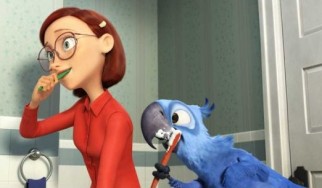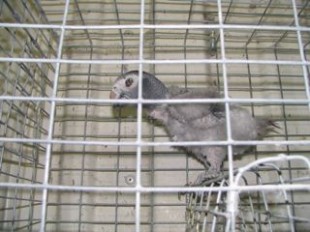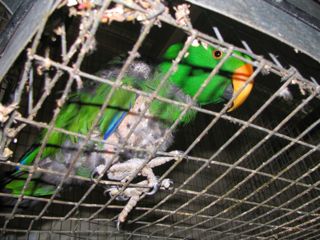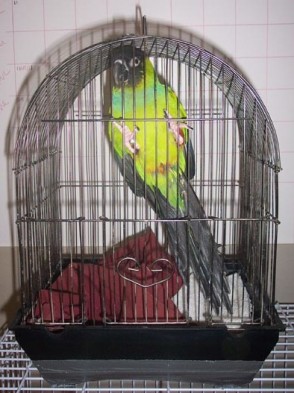Rio, the new 3D animated film about parrots from 20th Century Fox opened Thursday in theaters nationwide and has done blockbuster box office business. I'm concerned pet stores will be doing an impressive amount of parrot sales as a result.
That scenario is exactly what happened with clown fish after “Finding Nemo” came out and dalmatians after “101 Dalmatians.” An estimated 1 million clown fish were flushed down toilets and countless dalmatians ended up in rescues.
"Rio's" premise is an important issue, parrot smuggling, but “Nemo” had an important message too. The latter’s was the terrible way fish are trapped in nets, or captured to fill fish tanks as decorative items. All Nemo wanted was freedom. He escapes the tank gets back out to sea and reunites with family and friends. The audience rooted for him all the way and then they went out and bought a clown fish and stuck it in a tank. When kids figured out it wasn’t actually Nemo they neglected them. What happens when they discover their pet shop parrot doesn’t brush its beak like Blu, the Spix’s macaw star of the film pictured here? Will they still want it? Not so much…

Photos copyright 20th Century Fox
When it comes to kids and their unending desire to own what they like, it doesn't matter how noble the underlying message it's as if there never was one. You'd think their parents would throw some sense into the equation but, alas, that doesn’t seemed to happen either.
Here's a good example of what can happen. In this case it was wild parrots: Sulphur-crested cockatoos were drained from Indonesian islands when the hit TV series Baretta was on in the 1970s because the title character had one that talked and responded when spoken to. 25 years later the populations have not bounced back and the Sulphur-crested are on the endangered species list. The show wasn't even on TV that long, just 3 years from 1975-78 but it was enough to start and sustain a run on those ‘toos.
Parrot rescues across the US, 1500+ of them, are filled to capacity with unwanted birds. Why? Because parrots are wild animals and do not take well to domestication. After all is said and done, they do not make good pets. And they are living unfulfilled lives in captivity: they are unable to fly, flock, move freely, choose their mates, the list is endless. Even so, at last count bird breeders, according to the breeders themselves, were still churning out 2 million birds a year.
Unlike puppies of which a % are bred in puppy mills, all parrots for sale in the US (aside from those being smuggled in from Mexico, et al) are bred in parrot mills. The breeding pair are generally kept in small cages, cut off from other parrots around them (lest they be distracted from their purpose). Attached are some rare fotos of the inside of a typical parrot facility. This one was in Virginia and sanctioned by Kaytee pet products, the Hartz Mountain of parrots.



As soon as I found out about the film, I called the publicity dept & head of marketing & advertising (whom I worked with eons ago in NY) to see if I could get them on board to support the national campaign I’m launching and include parrot welfare info in their “Rio” campaign. He wanted to talk w/me but was in and out of meetings and ultimately neither he nor the senior publicist who said she’d get back to me, did. Granted, they were busy with other film releases, and this one, but the fact is 20th Century Fox’s intentions in making the film was to make as much money as possible, not for the welfare of parrots. The latter isn’t even on their radar.
Regardless of it’s nice message if parrots end up isolated and neglected in cages languishing for their decades-long lives because of it, then the film, like many others before it, will have done more damage to parrots than helped them.
The info above about parrot breeding and smuggling is detailed in my book, “Of Parrots and People: The Sometimes Funny, Always Fascinating, and Often Catastrophic Collision of Two Intelligent Species”(Viking 2009). It broke the news about parrot mills in the US.
A CALL TO ARMS FOR PARROT RESCUERS: You can gain much for your rescues, and parrots overall, by contacting your local TV stations Assignment Desks. Dial the main #, you'll get an operator or a prompt for the "news desk." Ask for an assignment editor. I started out at ABC News, that's how I know…
Tell them you are concerned about the repercussions of "Rio." Tell them how many unwanted parrots you have waiting for homes (if you're a sanctuary, how many have been turned over to you) and how many calls you get every month to take more. Say you want to warn people not to buy parrots on impulse because they don't know what they're getting into buy watching an animated kids film. That parrots are loud, need as much attention as a 2 year old (for 50 years), are destructive, loud, and, most of all they ARE NOT 'Rio" (Note: saying it’s bad for the animal will never get you as far as saying it’s bad for the people that buy them or eat them or… ).
Invite the TV crews to interview you at your rescue, or a foster rescuers home where there are multiple birds, large and small, to show that even the small ones get ditched!
Let them see your birds, all beautiful, now homeless. You may get more calls for unwanted parrots, par for the course as you know. But if you urge the public to support needy parrots instead of making more, you’ll also get lots of donations once people see the film.
For my part, I’m about to launch a national public awareness campaign about minimum cage sizes for captive parrots with the Humane Society of the US. It will disseminate more than the reasons for keeping a companion parrot in the largest possible cage. Though that information alone will improve the lives of millions of captive birds now and in the future. Especially extreme tragedies like this one:

Rescuers had to cut this bird out of its cage to retrieve it. It was put in while young and never let out. Then it was too big to come out. This is how it lived for years - with nothing but food and a perch.
The awareness campaign, geared to the mainstream public with and without parrots, will also enlighten them to the requirements and realistic expectations of keeping one. If I had a dollar for every person I’ve heard say “If I had known what I was getting myself into I’d never have bought one!” I’d be wealthy. My goal is eliminate any chance of getting rich that way by making sure everyone knows what they’d be getting into before they get a parrot instead of after.
If you’re reading this, your consciousness has now been raised. When you’re around people praising the film, which you will inevitably be (especially if you’re a parrot person), inform them. Don’t hold back. Countless thousands of parrots are depending on all of us to do our part and make “Rio” do more good than harm.

































